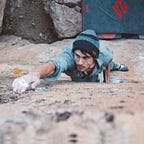A Brief History
The first time I climbed anything was at Mission Cliffs. I was walking down the street with my girlfriend and we decided to go in. We took an “Intro to Climbing” class, learned to belay, tie the figure eight, then we were on the walls, embracing our inner monkeys.
I was passionate about it — hauling myself up the wall with my arms, feet dangling; meanwhile my girlfriend was sending hard stuff with the strength and grace of a snow leopard. Er, a snow leopard that climbs? Whatever. She pointed out that I should use my legs more, but I was stubborn… so I just kept wearing myself out (eventually I wised up).
My girlfriend lived in Vancouver , and when she returned home I was out a partner — that’s when I discovered bouldering.
I hit it hard. I would go 4–5 times per week, spending a few hours each session. Despite the lack of structure and over-training, I leveled up quickly. Within a few months I was climbing V4 and flirting with V5.
But I injured myself — it was mild, a warning sign. I can only describe it as a deep aching pain in every joint in my arms. Not fun.
In retrospect, the problem was that I’d added too much training load too soon. Your body needs time to adapt to new stimuli. If you’re even asking yourself whether you’re overtraining, then the chances are the answer is yes. Any coach worth her salt knows it’s really easy to overtrain an athlete — the subtler challenge is to apply exactly the right training at the right time.
I didn’t know any of this then, so I ignored the pain until it got worse and I had to take time out. I languished for a while then restarted my training. Oh, the wasted time… sound familiar to anyone? Fellow climbers, if you’re experiencing pain that recurs, then you should lay off. Don’t aggravate your body — it will shut you down!
For about a year I bouldered. I became solid in the V5 range, on-sighting ~50% of the time, and with this clear progress I was spurred to try harder things. I began working on V6 and V7 problems, but never finishing them.
Back then I didn’t realize the value of focus. There was such a variety of problems to work on — especially with the opening of Dogpatch Boulders (a world-class bouldering gym in San Francisco) — that I began to suffer from a sort of bouldering ADD. I would flit from one problem to the next, being satisfied only with quick wins, never “projecting” problems that were out of my reach.
Eventually I started consciously challenging myself, and that’s when things really got going. I began to think of problems as falling into one of four categories:
- Easy — you might warm up on it.
- Comfortable— you can see how it would be done, but you might not on-sight it. No matter what, you’ll send the problem within a single gym session.
- Just out of reach — every move pushes you to the limit, one or two of the moves feel downright impossible, and chaining all the movements in succession is a pipe dream. There’s an outside chance you’ll get the problem in a single session, but in all likelihood it will take multiple sessions and some real focus (and the moon might have to be in the right phase).
- Impossible — it might as well be a V16. You can’t even start it. If you had a ladder you might be able to top it out.
(Which category do you think you should be focusing on?)
If a problem is “just out of your reach”, that is exactly the problem you should be working on. A chess grandmaster once told me that you should play only the opponents who are better than you, for that is how you advance.
If you’re spending all your time working on “Comfortable” problems, then you’re not going improve. I see climbers who send lots of V5’s, rarely work on V6’s and V7’s in a meaningful way, and yet bemoan the fact that they haven’t moved out of the V5 range. Silly, no? You have to challenge yourself to advance!
Twitter: @gabrielsilk
Facebook: facebook.com/gabrielsilk
